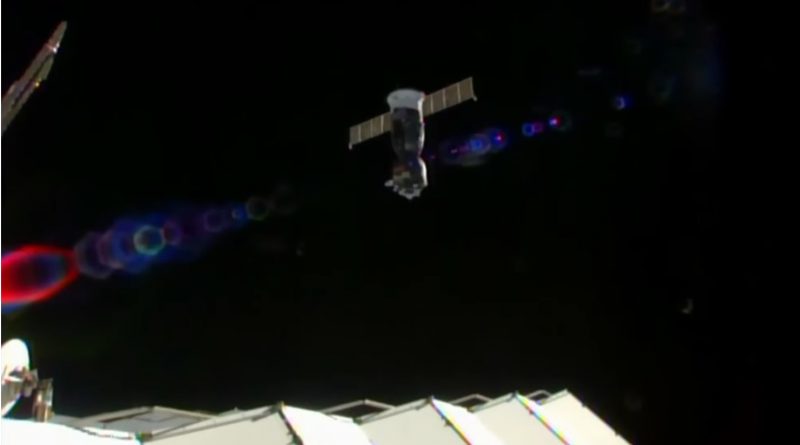Soyuz MS-02 with three Crew Members Departs ISS ahead of Afternoon Landing in Kazakhstan
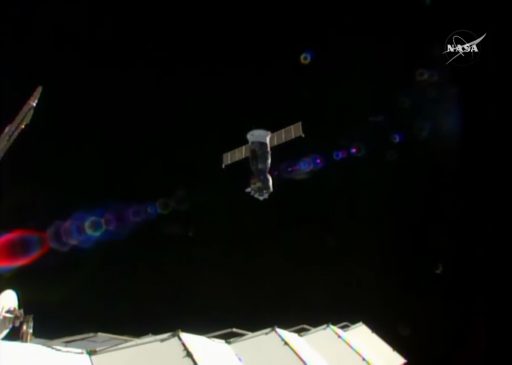
Three International Space Station crew members are on their way back to Earth after undocking from the orbiting laboratory early on Monday, set to ride through in a blaze of plasma and parachute to a late afternoon landing in Kazakhstan to close out a mission of 173 days.
Cosmonauts Sergei Ryzhikov, Andrei Borisenko and NASA Astronaut Shane Kimbrough set sail from ISS at 7:57 UTC aboard their Soyuz MS-02 spacecraft that fired its engines twice to depart the vicinity of the Space Station and head off on one and a half laps around the planet ahead of firing the spacecraft’s braking rocket at 10:28 UTC.
The critical deorbit burn will put the Soyuz onto a sub-orbital arc, intercepting the dense atmosphere at a precisely calculated location to carry the Soyuz craft toward its landing site in South Central Kazakhstan. Soyuz will hit the atmosphere half an hour after the braking burn, slowing down from 25 times the speed of sound to a complete stop in a period of just over 20 minutes.
Standing by in the landing area in the Kazakh steppe will be a fleet of ground-based vehicles and helicopters to rush toward the Soyuz spacecraft after it returns from space. Weather conditions are looking favorable with mostly clear skies, springtime temperatures around 16°C and light winds. The parachute-and-rocket-assisted touchdown of Soyuz MS-02 is expected at 11:21 UTC in a remote area 148 Kilometers south-east of the town of Dzhezkazgan.
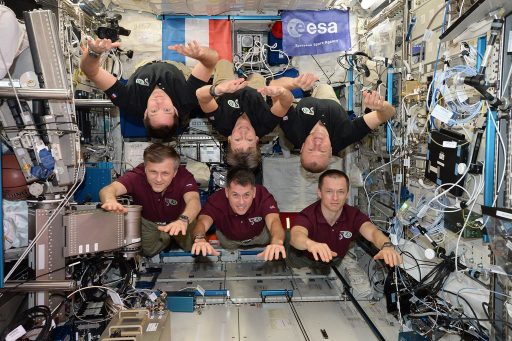
The Soyuz MS-02 flight is coming to an end after a six-month flight as part of ISS Expedition 49 and 50, launching on a two-day trip to ISS on October 19, 2016 as the second in the improved MS-class Soyuz vehicles. Aboard the orbiting laboratory, the crew supported over 200 scientific studies, welcomed five visiting spacecraft, oversaw the relocation of a docking port and supported four spacewalks dedicated to giving the Station a new set of batteries and preparing for the first Commercial Crew Vehicles to arrive at the complex next year.
Wrapping up their half-year mission, extended from a late March landing, the three crew members began preparing for their return three weeks ago, adjusting their daily exercise regime to get ready for the rigors of returning to gravity. Soyuz MS-02 was loaded with return cargo and underwent a detailed set of checkouts in the days before its landing – including external inspections by the Station’s robotic arm and a series of checkouts conducted by the crew including a test firing of the spacecraft’s thrusters.
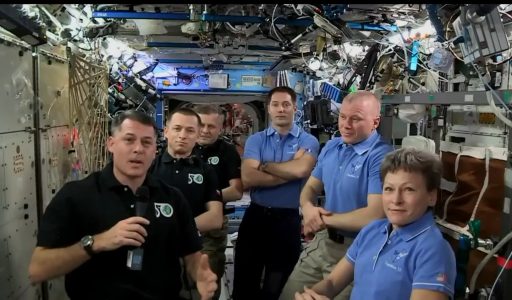
The crew themselves went through a fit check of their suits and seats as well as a series of procedure reviews and descent drills to make sure they are up to speed on the return sequence that awaits them.
On Sunday, outgoing ISS Commander Shane Kimbrough handed the reigns over to veteran astronaut Peggy Whitson who will be in command for ISS Expedition 51 for the next eight weeks. Whitson, now the first woman to command the International Space Station twice, recently received an extension of her stay from a landing in early June to a September 3rd homecoming, switching Soyuz spacecraft & taking advantage of an empty seat on the upcoming Soyuz MS-04 mission to keep an extra pair of hands in orbit for the summer.
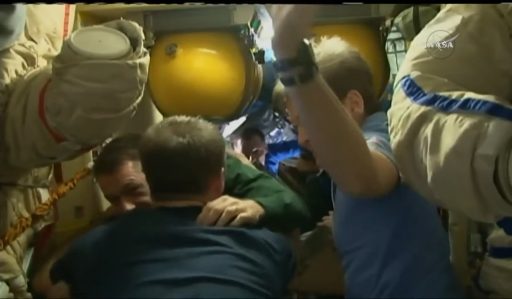
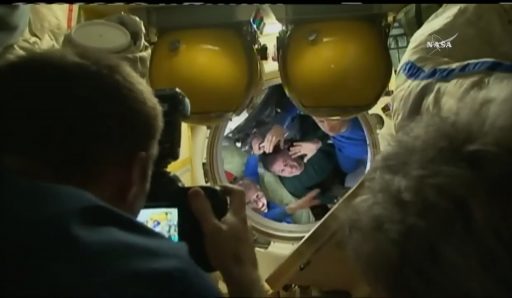
After Sunday’s Change of Command Ceremony, the Expedition 50 crew enjoyed a last meal as a six-member crew in orbit before the departing crew members placed the final return items aboard their spacecraft and inspected the craft’s docking mechanism and hatch seal. All crew members were able to catch a few hours of sleep before waking up in the very early hours on Monday for the activation of the Soyuz spacecraft.
While the crew was in the process of readying their ship for departure, a 300-strong recovery team mobilized in Kazakhstan to deploy to the primary Soyuz landing site in the Southern Landing Zone as well as the ballistic landing target 450km short of the bullseye target. Helicopters and fixed-wing aircraft were pre-staged to Karaganda and Dzhezkazgan, ready for departure to the landing site one hour before touchdown, while ground-based vehicles are departing several hours in advance to be in position when Soyuz arrives.
Part of the recovery team are members of Soyuz builder RSC Energia and Rosaviatsiya specialists who can locate and recover crews at all times of day and in adverse weather – skills that are not expected to be needed for Soyuz MS-02 that looks at favorable lighting and weather at the time of landing. Also part of the recovery team are representatives of NASA and Roscosmos to attend to their respective crew members after touchdown.
Soyuz MS-02 was put through a final set of systems initializations and checkouts under the watchful eye of Sergei Ryzhikov and Andrei Borisenko who put the expected flight parameters into the Digital Flight Control System of the spacecraft ahead of receiving a final update on maneuver times from Mission Control based on updated tracking information from ISS.
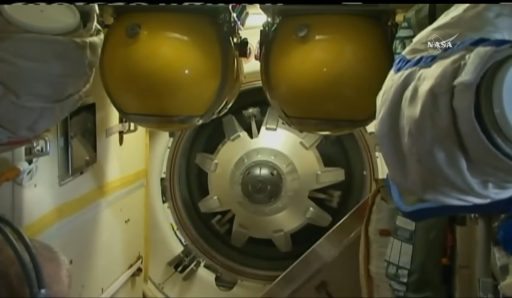
The three departing crew members and their colleagues who are staying in orbit gathered inside the Poisk module to say their farewells before the Soyuz trio traded the comforts of ISS for the confined space of their Soyuz for the three-hour undocking prep process. Sergei Ryzhikov closed and locked the Soyuz hatch at 4:45 UTC followed by the closure of the Poisk module’s hatch to seal off the Soyuz for the standard leak check.
Passing pressure readings from the docking interface to the ground every five minutes, the crew also used the time to put on their Kentavr Anti-G garments and Sokol Launch and Entry Suits that protect them in case Soyuz loses pressure on the way back to Earth.
Commander Sergei Ryzhikov, returning from his first space mission, strapped himself into the center seat while Andrei Borisenko, closing out his second long-duration mission, buckled into the left seat and two-time space flier Shane Kimbrough boarded the right seat. After pressure checks on their suits, the crew entered a final set of preparatory steps for their departure.
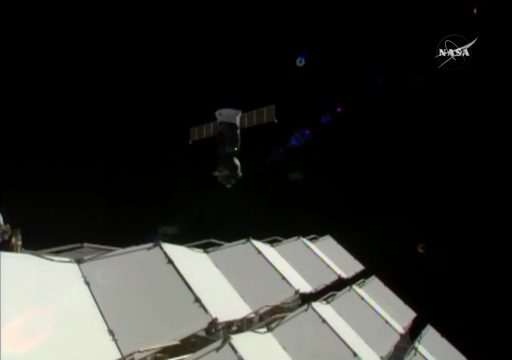
The Soyuz switched to autonomous power and umbilicals within the docking interface were demated to allow hooks on Poisk to be opened so that Soyuz was only held in place by its own hooks. The Space Station disabled the Russian thruster system and switched the Control Moment Gyros on the U.S. Segment to a Fine Attitude Hold Mode to hold sufficiently still for the undocking sequence. No attitude maneuver was carried out in advance of undocking as has become the norm due to ISS propellant considerations – requiring the Soyuz to fly a modified departure profile with two separation burns.
Soyuz powered up its docking mechanism five minutes before separation and the undocking command was issued 90 seconds in advance to trigger the opening of the hooks in order to structurally demate the Soyuz from the Poisk module so that loaded springs could push the Soyuz off.
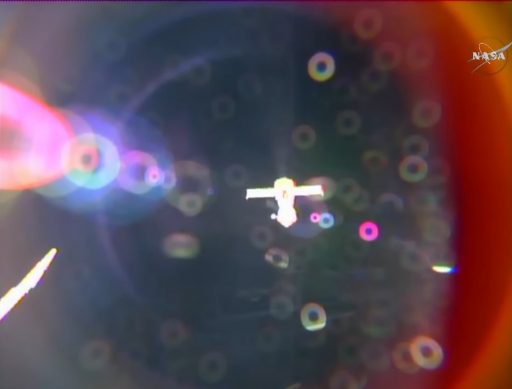
Physical separation was confirmed on time at 7:57:30 UTC while ISS was flying 400 Kilometers over China.
After undocking, the Soyuz re-enabled active motion control and drifted away at a speed of around 0.1 meters per second for three minutes before activating its DPO thrusters for an eight-second departure maneuver to accelerate by 0.5 meters per second along the Station’s R-Bar or radial vector, flying away from ISS toward the direction of space.
Immediately after the first separation burn, Soyuz went into a swift roll maneuver to position the thrusters for the second and largest departure burn a minute and 20 seconds after the first. This 15-second, 1.5m/s firing of the DPO thrusters delivered a thrust component along the velocity vector and set up the typical V-bar departure trajectory away from the Station.
With Soyuz out of the Station’s vicinity, the crew can relax for one and a half hours before beginning the setup for their return from orbit. Over the course of one and a half orbits, Soyuz will open a 12-Kilometer gap to ISS, but maintains a VHF link used to relay communications between Mission Control and the spacecraft.
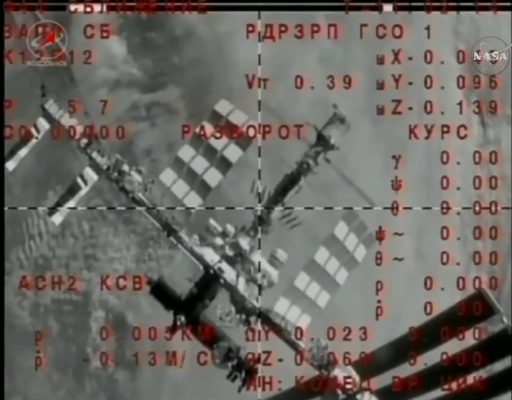
The crew will not have much to do during most of the free flight before pressing into deorbit prep one hour before the burn, starting with the reconfiguration of the craft’s navigation system and connecting the Entry Module’s emergency batteries to the power bus.
Soyuz will flip into a tail-first orientation and open up a protective cover shielding the SKD main engine while it sits idle for the craft’s stay at ISS. Ignition of the 300 Kilogram-force S5.80 main engine is planned at 10:28:30 UTC on a burn of 4 minutes and 37 seconds.
Hitting the brakes, Soyuz will slow down by 128 meters per second to transition from an orbital trajectory to a sub-orbital path that intercepts the atmosphere at a precise location to enable Soyuz to land in Kazakhstan. Commander Ryzhikov will keep close watch over the maneuver and read out a running tally of the achieved delta-v (change in velocity) and relevant parameters such as tank pressures and vehicle stabilization.
Upon completion of the critical deorbit burn, the crew will close their helmets and the Orbital Module will open up a valve to vent down to the vacuum of space to set up for the pyrotechnic separation of the three sections of the Soyuz, only one of which is outfitted to withstand the extreme environment of re-entry. Soyuz will be on a north-easterly heading at that point, crossing the Atlantic Ocean ahead of passing over the African continent one final time as the craft rapidly descends in altitude.
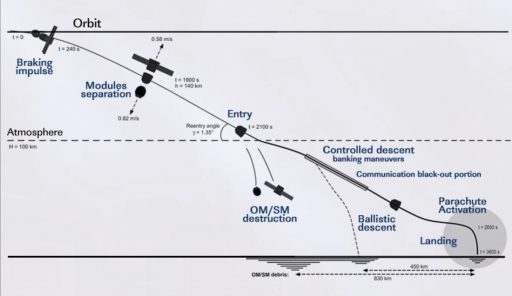
Communications with the three crew members, provided through a space-to-space link with ISS, will deteriorate noticeably as the gap between the craft increases and lengthy drop outs once Soyuz is under 200 Kilometers in altitude are a common occurrence.
A series of loud bangs will shake the Soyuz once crossing 140 Kilometers as pyrotechnics fire in close succession to split the spacecraft in three with loaded springs in charge of pushing the Orbital and Service Modules into opposite directions ahead of their destructive re-entry.
Soyuz will hit the atmosphere at 10:58:11 UTC as it descends through 100 Kilometers over the border of Iran and Iraq, beginning the 23-minute process of slowing down from a blazing speed of 7.6 Kilometers per second to a resting position in the Kazakh steppe. The Entry Module will hold a pre-programmed orientation for the first 89 seconds of entry before active entry guidance kicks in to take the spacecraft through a series of bank maneuvers to bleed off energy while also controlling its downrange travel distance by modifying lift on the capsule.
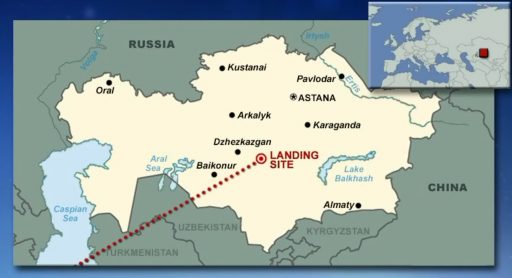
Barreling through a blaze of plasma, the three crew members will see their windows glowing bright yellow with pieces of the craft’s ablative heat shield passing by. The heat shield protects the spacecraft by slowly burning away and, in the process, creating a boundary layer between the extremely hot layer of crushed air in front of the spacecraft and the vehicle itself.
The crew can expect to pull a peak G load of five when passing 34 Kilometers in altitude, rapidly decelerating toward the planned parachute opening location.
Soyuz slows to a speed of around 210 meters per second for the opening of the parachutes 10.8 Kilometers in altitude. The three-stage deployment sequence begins with the release of a pair of Pilot Chutes that pull out the Drogue Chute – creating one of the most turbulent flight events as Soyuz shakes for around half a minute before stabilizing under the Drogue which slows the craft from 0.7 times the speed of sound to 80 meters per second.

As Soyuz passes 7.5 Kilometers in altitude, the large orange-and-white main chute will unfold to further slow the spacecraft and put it into a vertical descent toward the landing point. The automated landing program – starting around 5.5km in altitude – takes the Soyuz through a final series of steps to get ready for touchdown, dropping the heat shield to expose the landing thrusters and altimeter, re-hooking the spacecraft to a symmetrical arrangement under the chute, jettisoning the blackened window covers and equalizing the cabin pressure.
Soyuz is targeting a remote stretch of the Kazakh steppe for an afternoon touchdown at 5:21 p.m. local time, 11:21:05 UTC. A fleet of vehicles will be standing by on the ground to rush to the landing site while a series of helicopters will enter a racetrack around the projected landing point to touch down next to the spacecraft within minutes of landing.
Inside the spacecraft, the shock-absorbing seats will move up and the crew will brace for contact with Terra Firma that will be cushioned by solid-fueled landing engines which fire when landing is imminent. Soyuz is expected back on Earth after a mission of 173 days, 3 hours and 16 minutes.
Recovery forces will begin descending on the landing site to assist the returned crew members out of their capsule to be then seated in reclining chairs for a breath of fresh air after their return.

